Thimble, Threads and Needle
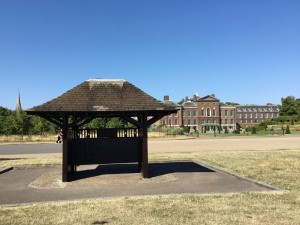
One of two Silver Thimble Fund Great War 1919 Memorial Shelters in Kensington Gardens.
(P. Ferguson image, August 2018)
Thread One
The heat is upon us as loose threads, from many previous investigations, are brought together in a single expedition across London. Firstly, a walk to Kensington Gardens where we are to encounter two memorial shelters of the Silver Thimble Fund. As we walk toward them, we see them across the pond, with Queen Victoria’s likeness, and her own pond flowers floating atop the circular moat. In the background Kensington Palace.
The Silver Thimble Fund was founded in 1915 by Miss Hope Elizabeth Hope-Clarke. The fund collected damaged thimbles made from precious metals which were then melted down to raise monies for the purchase of medical equipment. As one of the most successful charitable organizations of the Great War it collected, via 30 appeals and 160 collecting centres across the Commonwealth, 60,000 thimbles that were converted towards 15 ambulances, 5 motor hospital launches, 2 dental surgery vehicles, and a disenfector. How does one ever think upon a seemingly simple tool, the thimble, the same way again?
Two signs, in each of the shelters, record: Erected by The Silver Thimble Fund 1919 and In Memory of Our Soldiers Who Fought in the Great War 1914 – 1918.
From Kensington Gardens we head towards the Victoria and Albert Museum not so much to see inside but to view the damage to the structure during the Second World War. Walking down Exhibition Road we come across our goal, finding the pockmarks left behind by accelerated debris. The building is scarred but the V&A has accepted its look. This is not a facade to be fully repaired but to set within the context of the events.
The damage to these walls is a result of enemy bombing during the Blitz of the Second World War 1939 – 1945 and is left as a memorial to the enduring values of this great museum in a time of conflict.
We return to an old friend as we head towards the Royal Artillery [RA] Memorial featuring its 9.2” gun and bronze soldier statues at Hyde Park corner. Before we turn towards the gunners a stop to the nearby statue of David of the Machine Gun Corps Memorial reminds us, Saul has Slain His Thousands but David His Tens of Thousands. In contrast to one of the several inscriptions on the RA Memorial, designed by Charles Sargeant Jagger MC, Here Was a Royal Fellowship of Death.
South of Buckingham Palace we arrive on another landscape of loss of the Second World War. Somewhere along Wilfred Street two Canadians, Cicely Matson, age 43, and her daughter Mary Jane Theresa Matson, age 18, were killed Friday June 23, 1944 in a V-1 incident. Cicely’s eldest brother, Guy Simond’s, was one of Canada’s finest Second World War generals. The women’s story is little known.
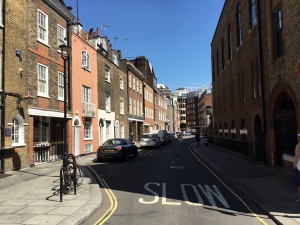
Wilfred Street where Canadian mother and daughter Cicely Matson and Mary Jane Theresa Matson were killed by a V-1.
(P. Ferguson image, August 2018)
We journey on toward Parliament Square having photographed, along the way, a suffragette memorial. As we arrive upon the square we encounter countless visitors jockeying for position in the tourist-scape. Immediately I choose not to find Churchill and Gandhi within a single frame. Its on to Whitehall stopping by the Cabinet War Rooms to reacquaint myself with Churchill’s work ethic.
As we make our way along the walkways towards Admiralty Arch we encounter the encumbered. Tired visitors from across the globe, overheated and exhausted, they unknowingly block the thoroughfares, wondering where they are and have become site blinded having seen so much. We are among them.
Refreshed after snacks and tea (even in the heat) we attempt to make our way to Rectory Road, but like a bridge too far it becomes a logistical impossibility due to rail issues and forces beyond our control.
We end our day at an obelisk, well outside our usual scape. Located along Victoria Embankment we stop to photograph Cleopatra’s “needle” a gift from the ruler of Egypt and Sudan in 1819. The red granite obelisk stands alongside the Thames calling out to tourists for images amongst its guardian Sphinxes. Nearby a Great War memorial, from the thankful people of Belgium to Britain, receives scant attention and recognition from visitors to the area. Like a single grain of sand, the Belgian Memorial is lost amongst the dunes of memory in London. Another thread to follow for another day.
With Cleopatra’s Needle rising above these dunes it has become a fitting way to call an end to our day that started with thimbles. Stone and silver, large and small…both ambitious…both equally precious…this day together.
—–SNIP—–

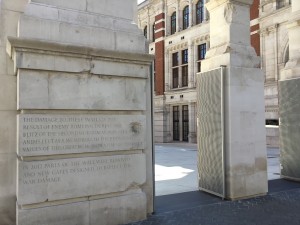
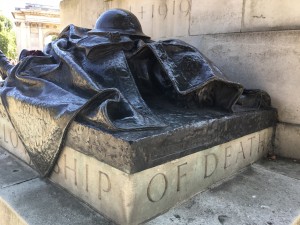
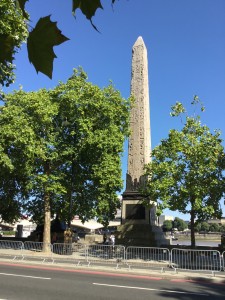
Comments